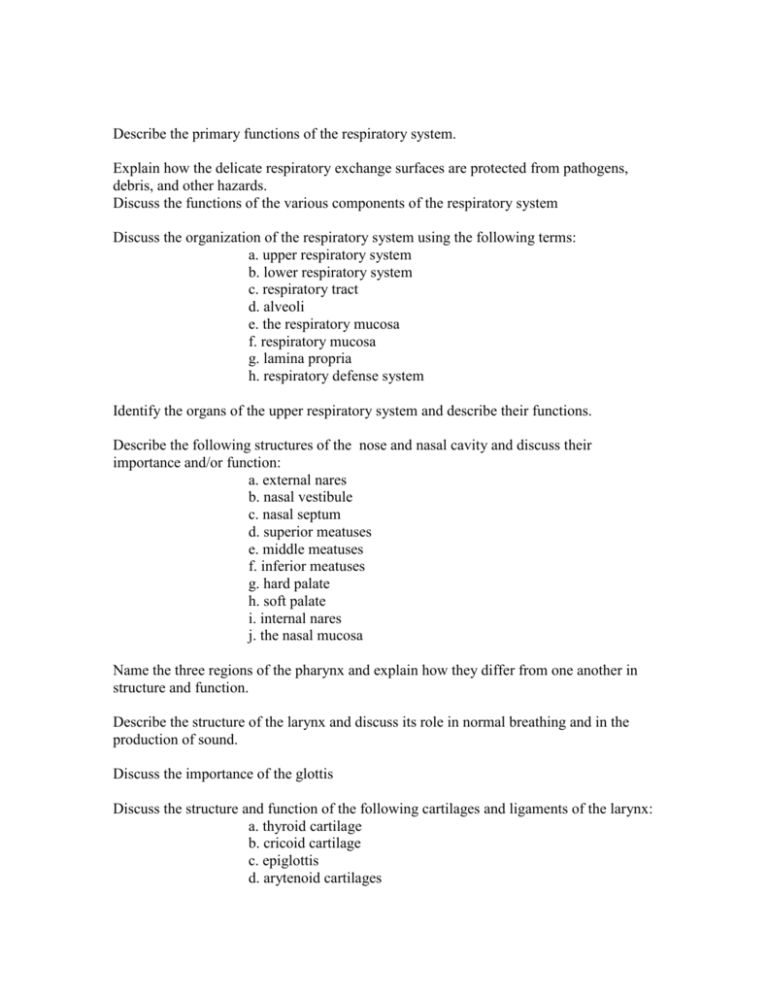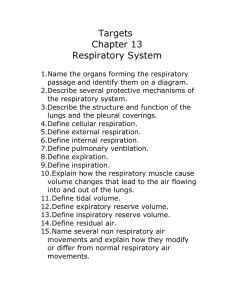review questions for respiration
advertisement

Describe the primary functions of the respiratory system. Explain how the delicate respiratory exchange surfaces are protected from pathogens, debris, and other hazards. Discuss the functions of the various components of the respiratory system Discuss the organization of the respiratory system using the following terms: a. upper respiratory system b. lower respiratory system c. respiratory tract d. alveoli e. the respiratory mucosa f. respiratory mucosa g. lamina propria h. respiratory defense system Identify the organs of the upper respiratory system and describe their functions. Describe the following structures of the nose and nasal cavity and discuss their importance and/or function: a. external nares b. nasal vestibule c. nasal septum d. superior meatuses e. middle meatuses f. inferior meatuses g. hard palate h. soft palate i. internal nares j. the nasal mucosa Name the three regions of the pharynx and explain how they differ from one another in structure and function. Describe the structure of the larynx and discuss its role in normal breathing and in the production of sound. Discuss the importance of the glottis Discuss the structure and function of the following cartilages and ligaments of the larynx: a. thyroid cartilage b. cricoid cartilage c. epiglottis d. arytenoid cartilages e. corniculate cartilages f. vestibular folds g. vocal folds h. vocal cords Explain how sound is produced. Distinguish between the vestibular an vocal sounds. Discuss the structure of the airways outside the lungs. Describe the following structures in the trachea and discuss their function : epithelium, submucosa, tracheal cartilages, and trachealis muscle Describe the structure of the right and left primary bronchi Define the following terms: a. carina b. hilus c. root .Describe the superficial anatomy of the lungs, the structure of a pulmonary lobule, and the functional anatomy of the alveoli. Describe the lobes of the lungs. Name the lung that has 3 lobes. Name the lung that has 2 lobes. Discuss the importance of the cardiac notch Describe the structure and discuss the function of the bronchi using the following terms: a. bronchial tree b. secondary bronchi c. tertiary bronchi d. bronchopulmonary segment e. bronchitis Describe the structure and discuss the function of the bronchioles using the following terms a. terminal bronchioles b. bronchodilation. c. bronchoconstriction d. asthma Describe the structure and function of the pulmonary lobules using the following terms: a. interlobular septa b. pulmonary lobules c. respiratory bronchioles Discuss the structure and function of the alveolar ducts and alveoli using the following terms: a. alveolar ducts b. alveolar sacs c. alveolar macrophages d. septal cells e. surfactant f. respiratory membrane g. pneumonia Name the two types of cells in the alveolar wall and discuss their function. List the parts of the respiratory membrane and explain why it is imperative that it be as thin as possible. Name two things that cause the lungs to recoil. Explain how surfactant reduce lung recoil. Explain what happens when there is an inadequate amount of surfactant in the alveoli. Distinguish between the blood supplied by the bronchial arteries and the pulmonary arteries. Define the term pulmonary embolism Describe the pleural cavities and pleural membranes and discuss their importance in resporation. a. pleural cavities b. pleura c. parietal pleura d. visceral pleura e. pleural fluid Define the term pleural pressure and explain to alveolar volume when pleural pressures decrease. Explain what causes pleural pressure to be lower than alveolar pressure. Explain how a hole in the chest wall can cause the lung to collapse. Explain what causes pleural pressure to decrease during inspiration and discuss the effect this has on alveolar pressure and air movement. Explain what cause pleural pressure to increase during expiration and discuss the effect this has on alveolar pressure and air movment. Define and compare the processes of external respiration and internal respiration. Describe the major steps involved in external respiration using the terms: external respiration and internal respiration. Define the terms hypoxia, and anoxia. Summarize the physical principles governing the movement of air into the lungs. Describe the origins, insertions and actions of the respiratory muscles responsible for respiratory movements. Define the term pulmonary ventilation. Discuss the role the following play in ventilation: a. atmospheric pressure b Gas Pressure and Volume (Boyle’s Law) c. Henry’s Law d. Charle’s Law c. Pressure and Airflow to the Lungs Define the term compliance and discuss what happens to lung expansion when compliance increases or decreases. Discuss the pressure changes that occur during inhalation and exhalation using the following terms: intrapulmonary pressure, intra-alveolar pressure, and intrapleural pressure. Define the terms pneumothorax and atelectasis. Discuss the respiratory cycle Name the muscles used in inhalation and the muscles used in exhalation. Distinguish between the main muscles and the accessory muscles. Define the following terms: a. quiet breathing b. eupnea c. diaphragmatic breathing d. deep breathing e. costal breathing f. shallow breathing g. elastic rebound h. forced breathing i. hyperpnea Define the term respiratory minute volume. Define the term alveolar ventilation Discuss the relationship between the anatomical and physiological dead space. Discuss how the dead spaces affect alveolar ventilation. Define the terms spirometry and spirometer. Define the following volume relationships: a. resting tidal volume b. expiratory reserve volume (ERV) c. residual volume d. minimal volume e. inspiratory reserve volume (IRV) f. inspiratory capacity g. functional residual capacity (FRC) h. vital capacity i. total lung capacity Summarize the physical principles governing the diffusion of gases into and out of the blood. Explain the important structural features of the respiratory membrane. Describe the partial pressures of oxygen and carbon dioxide in alveolar air, blood, and the systemic circuit. Discuss the importance of Dalton’s Law and Boyle’s Law Discuss diffusion between liquids and gases and the solubility coefficient Describe the composition of alveolar air and how it differs from atmospheric air. Discuss the efficiency of diffusion of oxygen versus carbon dioxide at the respiratory membrane Compare the partial pressures of oxygen and carbon dioxide in alveolar air and the alveolar capillaries Compare the partial pressures of carbon dioxide and oxygen in the systemic circuit Describe how oxygen is picked up, transported, and released in the blood. Discuss the structure and function of hemoglobin. Describe how carbon dioxide is transported in the blood. Define the term hemolglobin saturation. Discuss the oxygen-hemoglobin saturation curve. Discuss the relationship of hemoglobin and pH using the termsL a. Bohr effect b. carbonic anhydrase Discuss the relationship of hemoglobin and Temperature Discuss the relationship of hemoglobin and 2,3-bisphosphoglycerate (BPG) Discuss the differences between hemoglobin and fetal hemoglobin. Discuss how carbon dioxide is transported in the blood Discuss how carbonic acid is formed and its importance in the respiratory process. Explain the importance of the chloride shift Distinguish between carbaminohemoglobin and oxyhemoglobin. Discuss how oxygen and carbon dioxide are transported in the plasma. Describe the factors that influence the respiration rate. Identify and discuss reflex respiratory activity and the brain centers involved in the control of respiration. Discuss how the body maintains local regulation of gas transport and alveolar function Discuss the role of respiratory centers in the brain in controlling respiration Discuss the function of the dorsal respiratory group (DRG), the ventral respiratory group (VRG), the apneustic and the pneumotaxic enters Discuss the chemoreceptor reflexes. Define the following terms: a. hypercapnia b. hypoventilation c. hyperventilation d. hypocapnia e. apnea f. dypsnea g. eupnea h. respiratory arrest i. asphyxia j. suffocation k cyanosis l. ischemia m. hypoxia n. acute coriza o. carbon monoxide poisoning p. bronchial asthma q. bronchitis r. tuberculosis s. emphysema t. pneumonia u. pleurisy Discuss the baroreceptor reflexes Discuss the Hering-Breuer reflexes Define the term apnea. Briefly discuss how one can exert voluntary control of respiration Discuss the changes in the respiratory system that occur at birth Discuss the effect of aging on the respiratory system Discuss the signs and symptoms of the following respiratory disorders: a. bronchitis b. emphysema c. chronic obstructive pulmonary disease d. cystic fibrosis e. pulmonary fibrosis f. sudden infant death syndrome g. strep throat h. diphtheria i. common coryza j. laryngitis k. whooping cough l. tuberculosis m. pneumonia n. influenza o.histoplasmosis p. coccidiomycosis q. asthma r.lung cancer s. sinusitis t. hyaline membrane disease u. pneumothorax Discuss the following congenital heart disorders: a. Patent ductus arteriosus b. Atrial septal defect c. Ventricular septal defect d. Discuss the role of the lymphatic vessels in the lungs. Discuss the relationship of the respiratory system to the pulmonary circulation. Discuss the other roles of the pulmonary circulation. Discuss the fetal circulation Discuss the neonatal circulation and explain how it differs from the fetal.







